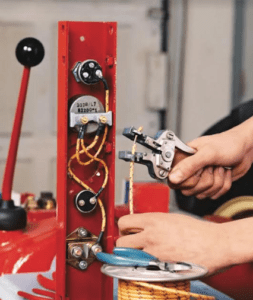Rewiring a tractor isn’t the place to skimp on restoration costs.
Compared to the cost of engine parts or a paint job, the expense of rewiring is nominal, said Dave Mowitz, antique tractor hobbyist.
Although it may look sound on the surface, old cloth or plastic-covered wiring may be long past its prime for transferring electricity efficiently. The best advice is to go with entirely new wiring.
A number of firms offer a wide selection of cloth wiring to match the original equipment on vintage tractors.
Selecting a wire size depends on a wide variety of conditions such as the voltage and amperage expected, where it is used (transferring power from the battery to the starter vs. from a magneto to a spark plug), and the length of its run.
As electricity moves through a wire, it builds up resistance, which creates heat. The longer the wire and the greater the load it carries, then the greater the resistance.
Using a wire that is too small in diameter can cause enough heat to be generated to melt a wire’s covering.
When sizing wiring to a job, remember that its carrying capacity must match the total load for a particular circuit.
The greater the load it has to carry and the longer the path it must run, the greater the resistance in the wire will be. This resistance can be reduced with a larger-diameter wire.
When in doubt, refer to your tractor’s service manual for the proper wire size recommendations.
If no recommendations are provided, check the wiring chart in an automotive guide. Many public libraries carry Chilton guides, which can be a great source of information.
A website that caters to the brand of tractor you are working on will likely have advice.
After buying the proper size wire, take care to install it properly. Use new terminal ends that are properly crimped or soldered to assure a solid connection.
Thoroughly clean original terminal ends to reduce resistance. Tighten locking washers when used, so they also make solid contact. I like to use terminal boots or a covering on all connections that are exposed to weather.
Other installation rules to follow are: Avoid sharp turns in wiring runs; Keep wiring away from high-heat surfaces; Always use a rubber grommet to protect wires passing through sheet metal; Run multiple wires in a harness or loom; Secure wiring using wire clamps or clips.
+++30+++
